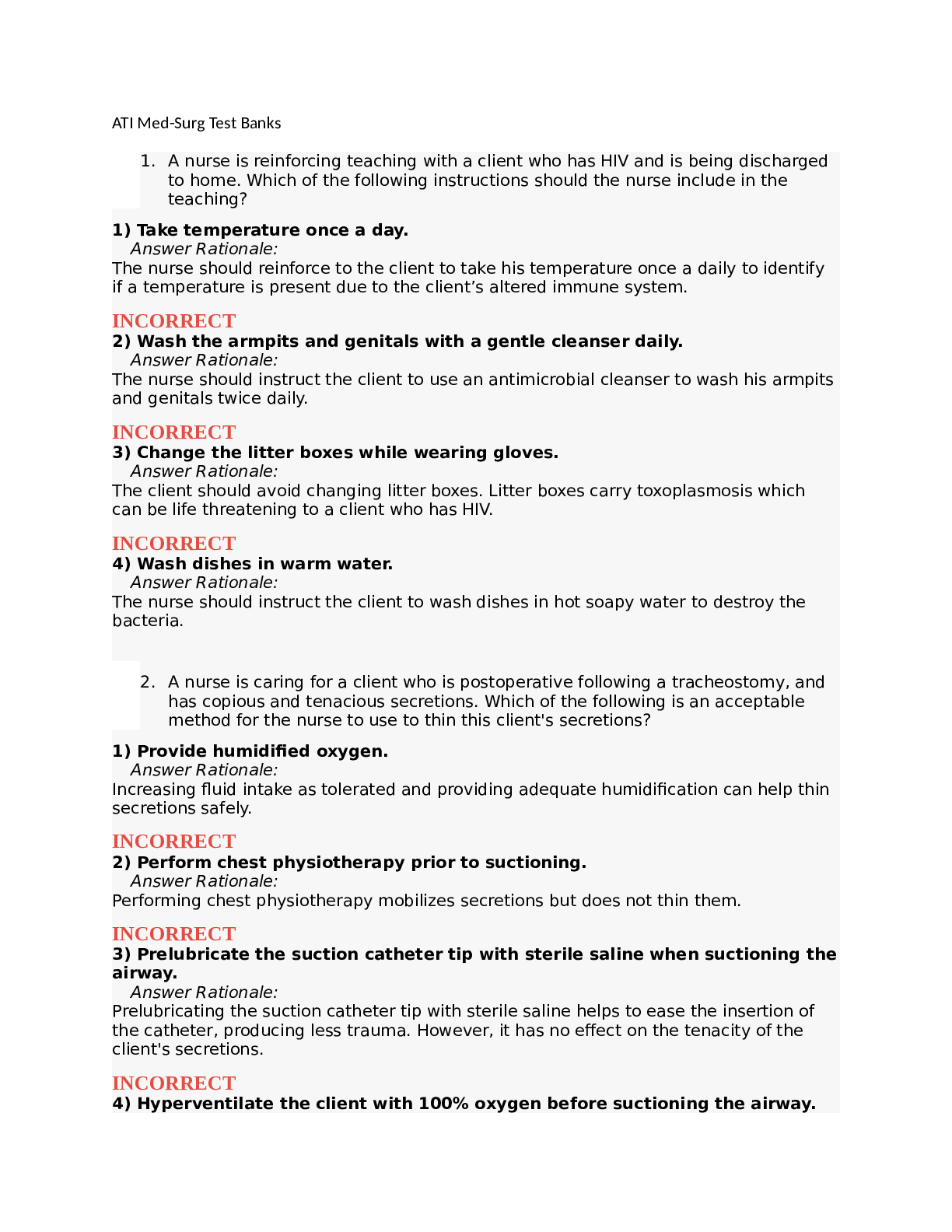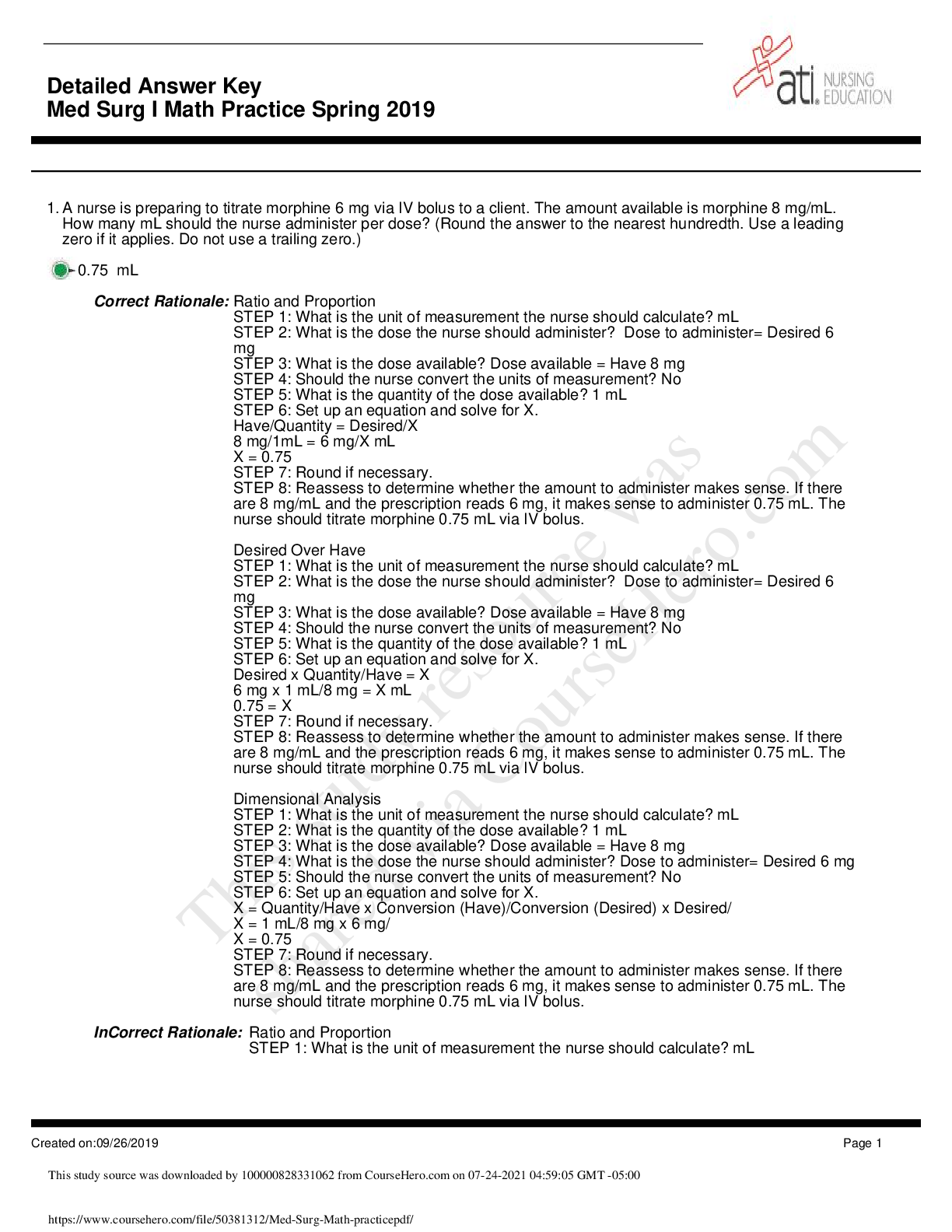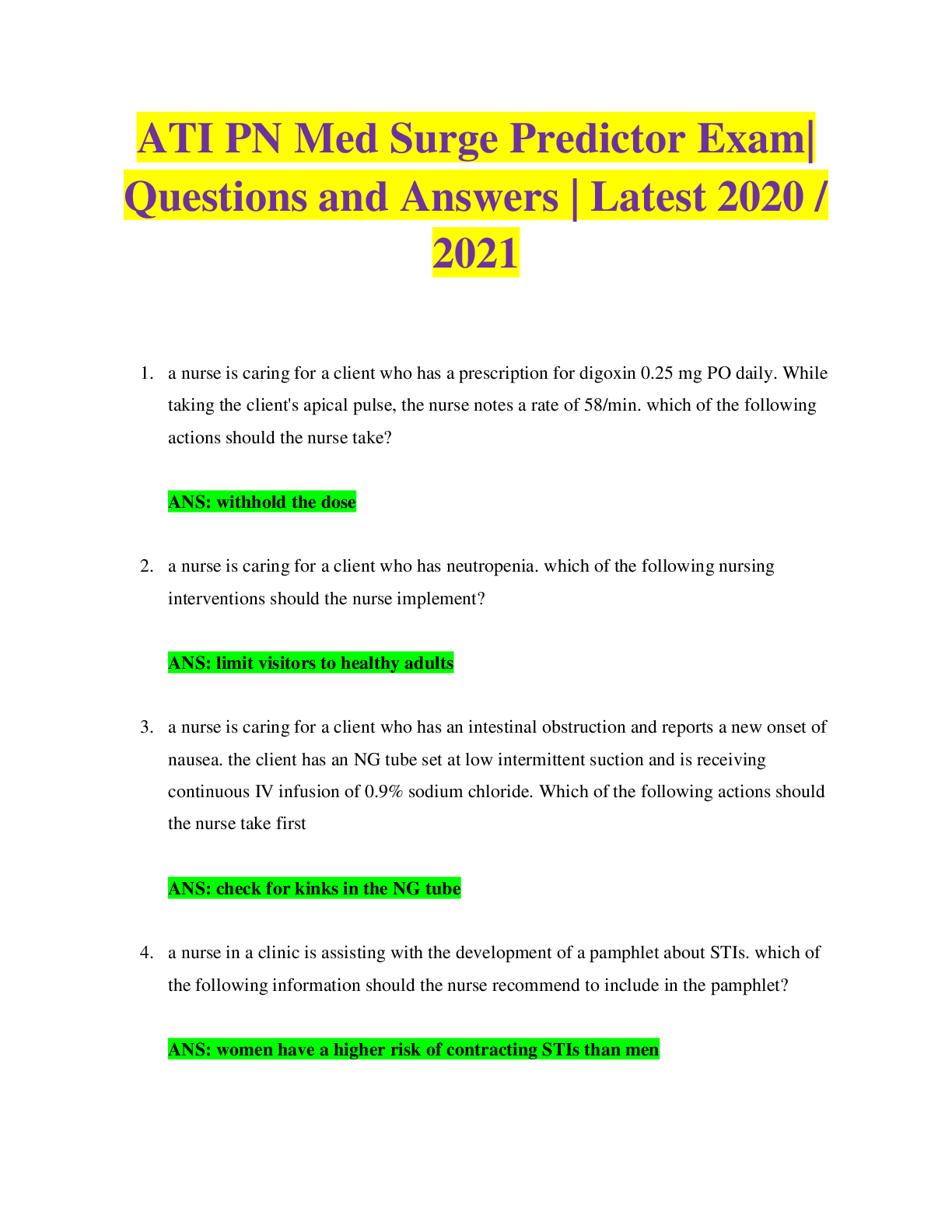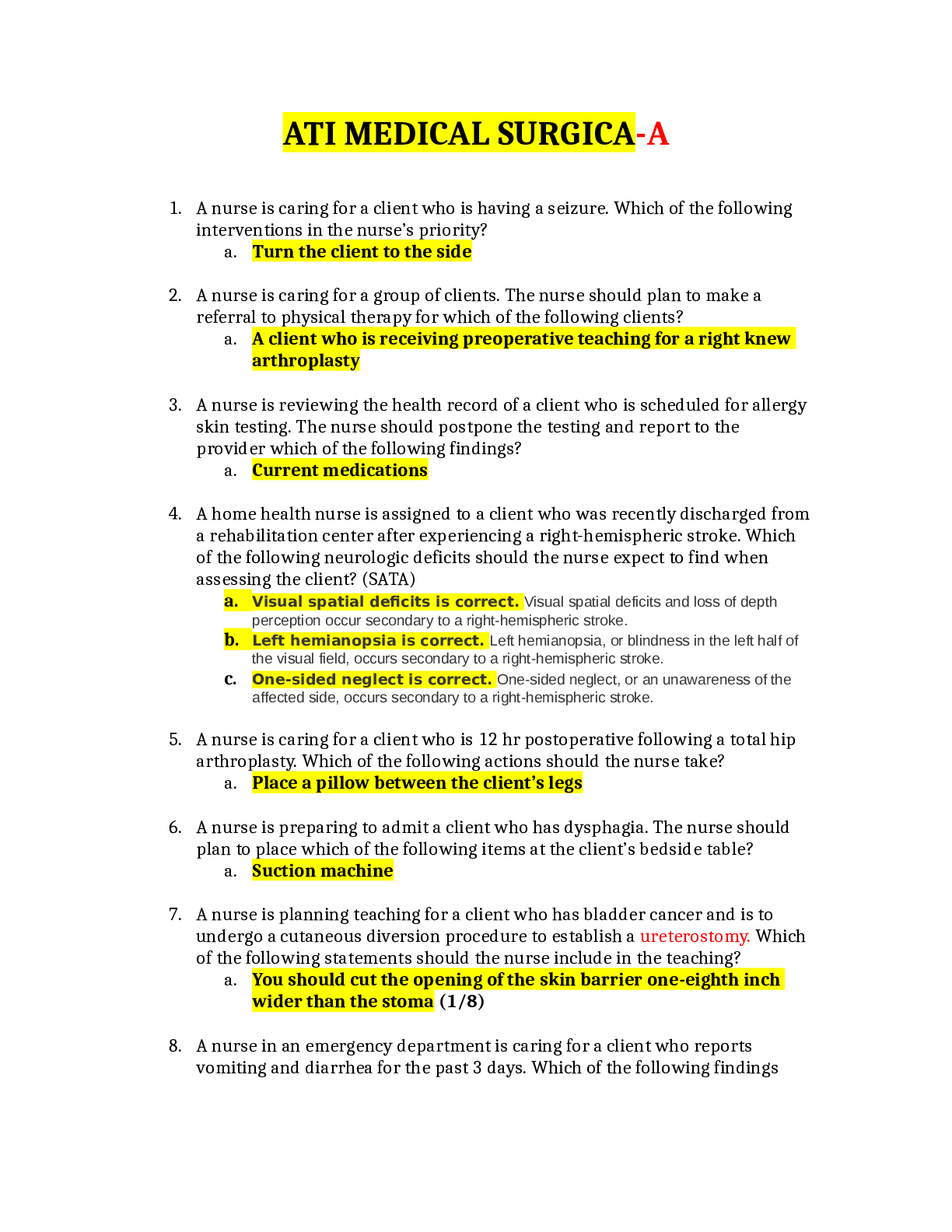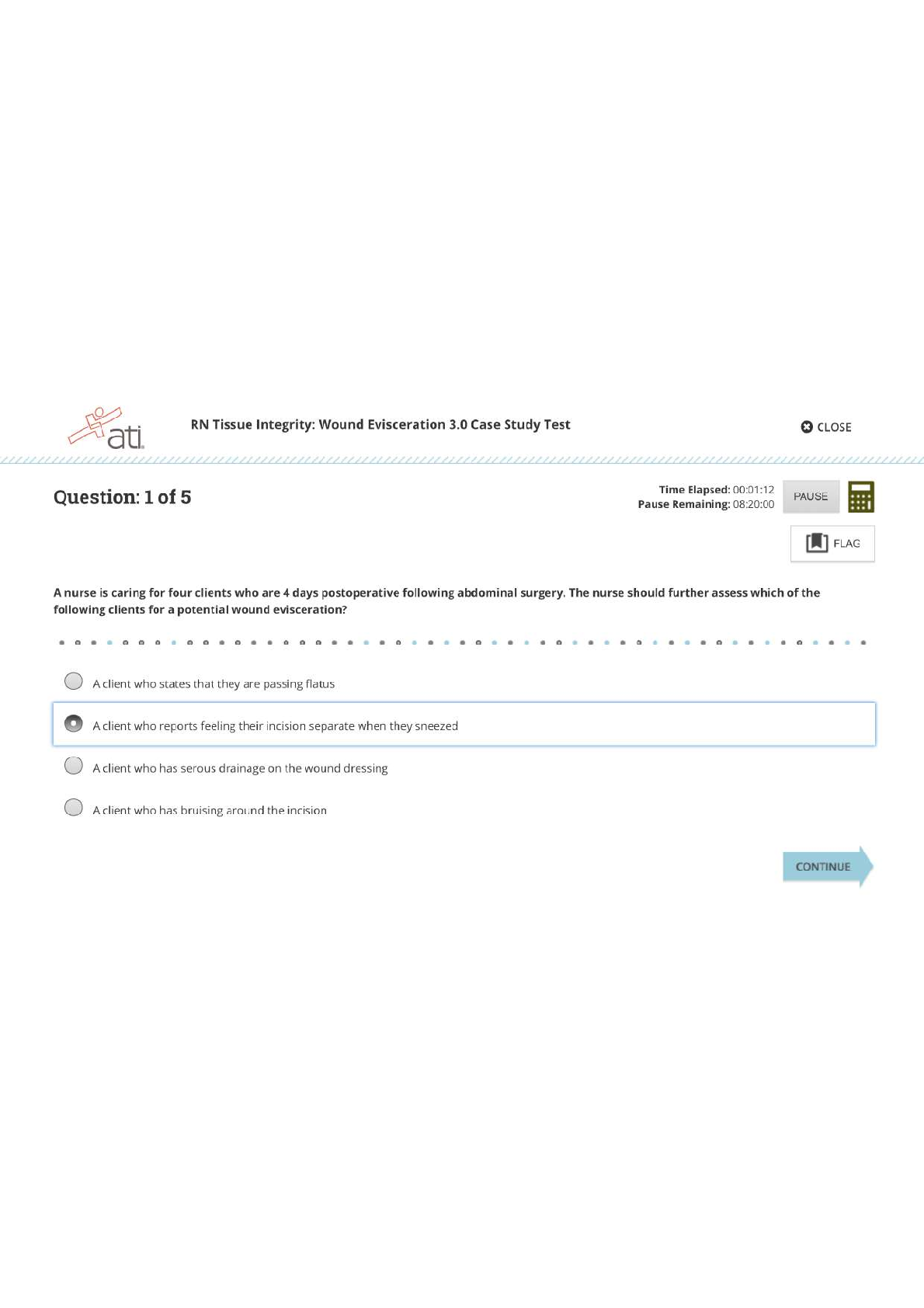*NURSING > ATI MEDICAL SURGICAL > ATI Proctored Exam Medical Surgical TEST BANK Form A (New Questions &Answers by ATI) | 100% CCorrect (All)
ATI Proctored Exam Medical Surgical TEST BANK Form A (New Questions &Answers by ATI) | 100% CCorrect Solution
Document Content and Description Below
ATI Proctored Exam Medical Surgical Form A 1. A nurse is preparing to administer thrombolytic therapy to a client who had an ischemic stroke. Which of the following is an appropriate nursing action? ... -Start the therapy within 8 hrs. (within 6 hrs.) -Insert an indwelling urinary catheter after therapy begins -Monitor blood pressure every 30 minutes during infusion. -Elevate the head of the bed between 25 and 30 degrees (to reduce ICP & promote venous drainage, ATI page 89) 2. A nurse is teaching a client about the use of an incentive spirometer. Which of the following instructions should the nurse include in the teaching? -Place hands on the upper abdomen during inhalation. -Exhale slowly through pursed lips. -Hold breath about 3 to 5 seconds before exhaling. (ATI page 138) -Position the mouthpiece 2.5 cm (1 in) from the mouth. 3. A nurse is assessing a client who is 12 hr. postoperative following a colon resection. Which of the following findings should the nurse report to the surgeon? -Heart rate 90/mm -Hgb 8.2 g/dL -Gastric ph of 3.0 -Absent bowel sounds Recall that bowel sounds are altered in patients with obstruction; absent bowel sounds imply total obstruction. QSEN: Safety (Book page 1143) 4. A nurse is caring for a client who has diabetes insipidus. Which of the following medications should the nurse plan to administer? -Regular Insulin -Furosemide -Desmopressin -Lithium Carbonate Teach patients with diabetes insipidus the proper way to self-administer desmopressin orally or by nasal spray. Management focuses on controlling symptoms with drug therapy. -The most preferred drug is desmopressin acetate (DDAVP), a synthetic form of vasopressin given orally, as a sublingual “melt,” or intranasally in a metered spray. The frequency of dosing varies with patient responses. Teach patients that each metered spray delivers 10 mcg and those with mild DI may need only one or two doses in 24 hours. -For more severe DI, one or two metered doses two or three times daily may be needed. 5. A nurse is admitting a client who has arthritic pain and reports taking ibuprofen several times daily for 3 years. Which of the following test should the nurse monitor? Stool occult blood -Urine for white blood cells -Fasting blood glucose -Serum calcium Assess for drug-related blood loss such as that caused by NSAIDs by checking the stool for gross or occult blood. Older white women are the most likely to experience GI bleeding as a result of taking these medications. (Book page 324) 6. A nurse in the emergency department is assessing a client. Which of the following actions should the nurse take first? (Click on the “Exhibit” button for additional information about the client. There are three tabs that contain separate categories of data.) -Obtain a sputum sample for culture. -Prepare the client for a chest x-ray. -Initiate airborne precautions (question sounds like a respiratory issue) -Administer ondansetron. 7. A nurse is contacting the provider of a client who has cancer and is experiencing breakthrough pain. Which of the following prescriptions should the nurse anticipate? -Intravenous dexamethasone -Transmucosal fentanyl -Oral acetaminophen- not strong enough -Intramuscular meperidine Fentanyl is a lipophilic (readily absorbed in fatty tissue) opioid and, as such, has a fast onset and short duration of action. It is recommended opioid for patients with end-organ failure because it has no clinically relevant metabolites. It also produces fewer hemodynamic adverse effects than other opioids; therefore, it is often preferred in patients who are hemodynamically unstable such as the critically ill. (Book page 59) 8. A nurse is admitting a client who reports chest pain and has been placed on a telemetry monitor. Which of the following should the nurse analyze to determine whether the client is experiencing a myocardial infarction? -QRS duration -ST segment -T-wave PR interval Examine the ST segment. The normal ST segment begins at the isoelectric line. ST elevation or depression is significant if displacement is 1 mm (one small box) or more above or below the line and is seen in two or more leads. ST elevation may indicate problems such as myocardial infarction, pericarditis, and hyperkalemia. ST depression is associated with hypokalemia, myocardial infarction, or ventricular hypertrophy. (Book page 670) 9. A nurse is teaching a client who has ovarian cancer about skin care following radiation treatment. Which of the following instructions should the nurse include? -Apply over the counter moisturizer to the radiation site -Cover the radiation site loosely with a gauze wrap before dressing -Use a soft washcloth to clean the area around the radiation site -Pat the skin on the radiation site to dry it. (Book page 390) Skin Protection During Radiation Therapy • Wash the irradiated area gently each day with either water or a mild soap and water as prescribed by your radiation therapy team. • Use your hand rather than a washcloth when cleansing the therapy site to be gentler. • Rinse soap thoroughly from your skin. • If ink or dye markings are present to identify exactly where the beam of radiation is to be focused, take care not to remove them. • Dry the irradiated area with patting rather than rubbing motions; use a clean, soft towel or cloth. • Use only powders, ointments, lotions, or creams that are prescribed by the radiation oncology department on your skin at the radiation site. • Wear soft clothing over the skin at the radiation site. • Avoid wearing belts, buckles, straps, or any type of clothing that binds or rubs the skin at the radiation site. • Avoid exposure of the irradiated area to the sun: • Protect this area by wearing clothing over it. • Try to go outdoors in the early morning or evening to avoid the more intense sun rays. • When outdoors, stay under awnings, umbrellas, and other forms of shade during the times when the sun's rays are most intense (10 AM to 7 PM). • Avoid heat exposure. 10. A nurse is caring for a client who is receiving a blood transfusion. The nurse observes that the client has bounding peripheral pulses, hypertension, and distended jugular veins. The nurse should anticipate administering which of the following prescribed medications? Acetaminophen -Furosemide (this patient has fluid overload from the transfusion) Diphenhydramine Pantoprazole 11. A nurse is assessing a client who is receiving magnesium sulfate IV for the treatment of hypomagnesemia. Which of the following findings indicates effectiveness of the medication? -Lungs clear -Hypoactive bowel sounds- Reduced motility, anorexia, nausea, constipation, and abdominal distention are common. A paralytic ileus may occur when hypomagnesemia is severe. -Blood pressure 90/50 mm Hg-hypomagnesemia causes hypertension, but this is too low, abnormal -Apical pulse 82/min One aspect of the conduction problems is that, when serum magnesium levels are low, intracellular potassium levels are also low. This changes the resting membrane potential in cardiac muscle cells, slowing normal conduction and triggering ectopic beats. 12. A nurse is preparing a client for a lumbar puncture. Which of the following images indicates the position the nurse should assist the client into for this procedure? - “Cannonball position on the side” picture #4 (ATI page 20) 13. A nurse is reviewing a clients ABG results: pH 7.42, PaCO2 30 mm Hg, and HCO3 -21 mEq/L. The nurse should recognize these findings as an indication of which of the following conditions? -Compensated respiratory alkalosis -Uncompensated respiratory acidosis -Metabolic acidosis -Metabolic alkalosis 14. A nurse is preparing to administer daily medications to a client who is undergoing a procedure at 1000 that requires IV contrast dye. Which of the following routine medications to give at 0800 should the nurse withhold? -Metoprolol -Metformin -Fluticasone -Valproic Acid 15. A nurse is planning care for a client who is experiencing seizures secondary to meningitis. Which of the following interventions should the nurse include in the plan of care? (Select all that apply.) -Assist the client to ambulate every 4 hr. -Place a tongue blade at the bedside. -Have suction equipment at the bedside. -Dim the overhead lights. -Apply a warming blanket. 16. A nurse is caring for a client who has a pressure ulcer with necrotic tissue and requires wet to damp dressing changes daily. Which of the following types of debridement should the nurse include in the plan of care? -Enzymatic -Surgical -Autolytic -Mechanical 17. A nurse is caring for a female who has toxic shock syndrome. Which of the following findings should the nurse expect? -Elevated platelet count -Decreased total bilirubin -Generalized rash -Hypertension 18. A nurse is preparing to administer a medication for a client though a non-tunneled percutaneous central catheter. Which of the following actions should the nurse take? -Close the inline clamp -Apply a local anesthetic to the skin -Don sterile gloves -Flush the catheter with 10 mL of 0.9% sodium chloride. 19. A nurse is caring for a client who was admitted with nausea, vomiting, and a possible bowel obstruction. An NG tube is placed and set to a low intermittent suction. Which of the following findings should the nurse report to the provider? -The client reports being extremely thirst with a sore throat -The drainage is bright green in color with brown fecal material -The amount of drainage is gradually decreasing -The client’s abdomen becomes distended and firm. 20. A nurse is reviewing the medical record of a client who has diabetes insipidus. Which of the following findings should the nurse expect? -Elevated blood pressure -Hypothermia -Urine specific gravity 1.001 -Bun 15 mg/d: 21. The nurse is caring for a client who has hyperthyroidism and develops thyroid storm. Which of the following instructions should the nurse give to the client regarding management of thyroid storm? -You will need to begin taking an ACE inhibition medication -You will need a pacemaker to increase your heart rate -You will need a cooling blanket to lower your body temperature -You will need additional thyroid supplementation 22. The nurse is reviewing the medical record of a client who has acute gout. The nurse should expect an increase in which of the following laboratory results? -Uric acid -Intrinsic factor -Creatinine kinase -Chloride level 23. A nurse is preparing to administer peritoneal dialysis to a client. Which of the following actions should the nurse take? -Use clean technique to access the catheter -Chill the dialysate before administration -Hang the drainage bag below the client’s abdomen -Place the client in high-Fowler’s position. 24. A nurse in the emergency department is caring for a client who has deep partial thickness burns over 30% of his body, including his upper chest and abdomen. Which of the following actions is the nurse priority? -Insert an 18-gauge IV catheter -Administer tetanus toxoid -Check the clients mouth for black particles -Remove the clients burned clothing. 25. A nurse is presenting an in-service program about Parkinson’s disease (PD). Which of the following statements should the nurse include in teaching? -PD results form a decreased amount of dopamine in the client’s brain -PD causes clients to have an increased sympathetic nervous system response -PD results in the development of neurofibrillary tangles within the client’s brain -PD manifestations worsen due to the clients decreased production of acetylcholine 26. A nurse is caring for a client who has a serum sodium level of 150 mEq/L. Which of the following actions should the nurse take? -Increase sodium in the client’s diet -Administer hypotonic IV fluids to the client -Restrict the client’s oral fluid intake -Administer a beta blocker 27. A nurse is caring for a client who takes lisinopril for hypertension. Which of the following client statements indicates an adverse effect of the medication? -I seem to be bruising more easily -I have a nagging, dry cough -I have a heightened sense of taste -I have to urinate frequently 28. A nurse is providing discharge teaching to a client following a modified left mastectomy with breast expander. Which of the following statements by the client indicates an understanding of the teaching? -I will perform strength-building arm exercises using a 15-pound weight -I should expect less than 25 mL of secretions per day in the drainage devices -I will keep my left arm flexed at the elbow as much as possible -I will have to wait 2 months before additional saline can be added to my breast expander 29. A nurse is caring for a client who has diabetes mellitus and has been following a treatment plan for 3 months. Which of the following laboratory results should the nurse monitor to determine long-term glycemic control? -Oral glucose tolerance test results -Fasting blood glucose level -Glycosylated hemoglobin level -Postprandial blood glucose level 30. A nurse is providing discharge teaching to a client who has chronic urinary tract infections. The client has a prescription for ciprofloxacin 250 mg PO twice daily. Which of the following instructions should the nurse include in the teaching? -Take a laxative to prevent constipation -Drink 2 to 3 L of fluids daily -Take an antacid 30 min before taking the medication -Monitor heart rate once daily 31. A nurse is providing teaching to a client who has a deep-vein thrombosis (DVT). Which of the following findings should the nurse identify as a risk factor for the development of DVTs? NSAID use Cirrhosis Hypertension Oral contraceptive use 32. A nurse is caring for client who has Cushing’s disease. Which of the following actions should the nurse take first? (Click on the Exhibit button below for additional information about the client. There are three tabs that contain separate categories of data.) -Auscultate the client’s lung sounds -Check the client’s medication administration record for antihypertensive medications -Determine the need for further glucose monitoring -Verify the client’s understanding of sodium restriction 33. A nurse is assessing a client who has nephrotic syndrome. Which of the following findings should the nurse expect? -Proteinuria -Hyperalbuminemia -Flank pain -Hypotension 34. A nurse is preparing to administer a 250 mL IV bolus of dextrose 5% in water to infuse over 2 hr. for a client. The drop factor is 10 gtt./mL. The nurse should set the pump to administer how many gtt./min? (Round the answer to the nearest whole number. Use a leading zero if it applies. Do not use a trailing zero.) gtt./min (change 2 hours to minutes = 120 minutes) 250 mL x 10 gtts/mL = 21 gtts/mL. 120 mins. 35. A nurse is assessing a client who has right-sided heart failure. Which of the following assessment findings should the nurse expect to find? -Poor skin turgor -Pitting edema -Oliguria -S3/S4 galloping heart sounds 36. A nurse is caring for a client who has a newly inserted chest tube. The nurse should clarify which of the following prescriptions with the provider? -Administer morphine 2 mg IV bolus every 3 hr. PRN for pain -Vigorously strip the chest tube twice daily -Notify the provider when tidaling creases -Assist the client out of bed 3 times daily 37. A nurse is teaching a client who is taking an ACE inhibitor for heart failure. Which of the following instructions should the nurse include for home management of heart failure? -Limit daily activity -Obtain daily weight -Monitor intake and output -Use a salt substitute 38. A nurse is providing discharge teaching to a client who has a permanent pacemaker. Which of the following statements by the client indicates an understanding of the teaching? -I need to check my pulse rate every day for a full minute -When a microwave oven I in use, I need to stay out of the room -I need to maintain pressure over the pacemaker site with an elastic bandage -The pacemaker will deliver a shock if I develop a dysrhythmia 39. A nurse in a clinic is providing preventive teaching to an older adult client during a well visit. The nurse should instruct the client that which of the following immunizations are recommended for healthy adults after age 60? (Select all that apply.) -Influenza -Human Papillomavirus -Meningococcal -Herpes Zoster -Pneumococcal polysaccharide 40. A nurse is assessing a client who is 4 hr. postoperative following arterial revascularization of the left femoral artery. Which of the following findings should the nurse repot to the provider immediately? -Urine output 150 mL over 4 hr. -Pallor in the affected extremity -Bruising around the incisional site -Temperature of 37.9 C (100.2 F) 41. A nurse is caring for an older adult who has not been eating. Which of the following findings indicate dehydration? -Capillary refill of 2 seconds -Engorged neck veins -Crackles auscultated bilaterally -Diminished peripheral pulses (thready pulse) 42. A nurse is preparing to discharge a client who has a halo device and is reviewing prescriptions from the provider. The nurse should clarify which of the following prescriptions with the provider? -May place a small pillow under the head when sleeping -Take tub baths instead of showers -Increase intake of fiber-rich foods. -May operate a motor vehicle when no longer taking analgesics 43. A nurse is assessing for early signs of compartment syndrome for a client who has a short- leg fiberglass cast. Which of the following findings should the nurse expect? -Bounding distal pulses -Intense pain with movement -Capillary refill less than 2 seconds -Erythema of the toes 44. A nurse is caring for a client who is postoperative following coronary artery bypass surgery and reports shortness of breath. The nurse administers oxygen at 3 L/min and obtains arterial blood gases 60 min later. Which of the following laboratory findings indicates a positive response to the oxygen therapy? -pH 7.32 -PaCO2 34 mm Hg -Pa02 90 mm Hg -Bicarbonate 20 mEq/L 45. A nurse is preforming a cranial nerve assessment on a client following a head injury. Which of the following findings should the nurse expect if the client has impaired function of the vestibulocochlear nerve (cranial nerve VIII)? -Loss of peripheral vision -Deviation of the tongue from midline -Disequilibrium with movement -Inability to smell 46. A nurse is caring for a client admitted with a skull fracture. Which of the following assessment findings should be of greatest concern to the nurse? -Bilateral pupil diameter changes from 4 to 2 mm -Glasgow Coma Scale score changes from 14 to 9 -Pulse pressure changes from 30 to 20 mm/hg -WBC count changes from 9,000 to 16,000/mm3 47. A nurse is caring for a client who presents to the emergency department after experiencing a heat stroke. Which of the following actions should the nurse take? -Administer an antipyretic -Apply a cooling blanket -Assess axillary temperature every 15 min. -Administer lactated Ringer’s 48. A nurse is caring for a client who is taking furosemide. The client has a potassium level of 3.1 mEq/L. Which of the following should the nurse assess first? -Muscle weakness -Urine output -Level of orientation -Cardiovascular status 49. A nurse is caring for a client who is scheduled for an abdominal paracentesis. The nurse should plan to take which of the following actions? -Administer a stool softener following the procedure -Instruct the client to take deep breaths and hold them during the procedure -Assist the client into the left lateral position during the procedure -Ask the client to empty his bladder prior to the procedure 50. A nurse is caring for a client who is 6 hr. postoperative following a thyroidectomy. The client reports tingling and numbness in the hands. The nurse should identify this as a sign of which of the following electrolyte imbalances? -Hypernatremia -Hypocalcemia -Hypermagnesemia -Hypokalemia 51. A nurse is assessing a client 15 min after the start of a transfusion of 1 unit of packed RBCs. Which of the following findings is an indication of a hemolytic transfusion reaction? -Hypotension -Hypothermia -Bradypnea -Bradycardia 52. A nurse in an emergency department is caring for a client who has sinus bradycardia. Which of the following actions should the nurse take first? -Administer atropine to the client -Initiate IV therapy for the client -Measure the client’s blood pressure -Prepare the client for temporary pacing 53. A nurse is caring for a client who has a prescription to discontinue a peripherally inserted central catheter. Which of the following should the nurse take? -Place a dry sterile dressing to the site after removal -Measure the catheter after removal -Apply slight pressure when resistance is met -Remove the catheter with one continuous motion 54. A nurse is assessing a client who has skeletal traction for a femoral fracture. The nurse notes that the weights are resting on the floor. Which of the following actions should the nurse take? -Remove one of the weights -Increase the elevation of the effected extremity -Pull the client up in bed -Tie knots in the ropes near the pulleys to shorten them 55. A nurse is caring for a client who has a flail chest. Which of the following actions should the nurse take? -Implement fluid restriction -Administer antibiotic medication -Administer acetaminophen orally -Provide humidified oxygen 56. A nurse is teaching a group of newly licensed nurses about acute respiratory failure. Which of the following manifestations should the nurse include in the teaching? -Hypocarbia -Hypoxemia -Hyperventilation -Hypovolemia 57. A nurse is caring for a client who is experiencing a seizure. Which of the following actions should the nurse take first? -Clear items from the client’s surrounding area. -Obtain the client’s vital signs -Loosen the client’s restrictive clothing -Lower the client to the floor 58. A nurse is teaching a client who is receiving total parenteral nutrition at home through a central venous access device about transparent dressing changes. Which of the following instructions should the nurse include in the teaching? -Use clean technique when changing the dressing -Wear a mask during the dressing change -Replace the extension tubing with each dressing change -Change the dressing every 48hr. 59. A nurse is caring for a client in the emergency department who experienced a full-thickness burn injury to the lower torso 1 hour ago. Which of the following findings should the nurse expect? -Decreased respiratory rate -Urinary diuresis -Hypotension -Bradycardia 60. A nurse in an emergency department is assessing a client who has cirrhosis of the liver. Which of the following is a priority finding? -Yellow sclera -Mental confusion -Palmar erythema -Spider angiomas 61. A nurse is providing instructions about foot care for a client who has peripheral arterial disease. The nurse should identify that which of the following statements by the client indicates an understanding of the teaching? -I apply a lubricating lotion to the cracked areas on the soles of my feet every morning -I use my heating pad on a low setting to keep my feet warm -I soak my feet in hot water before trimming my toenails -I rest in my recliner with my feet elevated for about an hour every afternoon 62. A nurse is teaching a client who has a new prescription for (alendronate to treat) osteoporosis. Which of the following instructions should the nurse include in the teaching? -Swallow the medication with 120 mL (4oz) of water -Sit upright for 30 min. after taking the medication -Take the medication with lunch -Take the medication with a vitamin E supplement 63. A nurse is teaching a client about using a metered-dose rescue inhaler. Which of the follow statement should the nurse include in the teaching? -Exhale fully before bringing the inhaler to your lips -Do not shake your inhaler before use -Use peroxide to clean the mouthpiece of your inhaler -Depress the canister after you exhale 64. A nurse is admitting a client to the emergency department after a gunshot wound to the abdomen. Which of the following actions should the nurse take to help prevent the onset of acute kidney failure? -Imitate beta blocker therapy -Administer IV fluids to the client -Insert a urinary catheter -Prepare the client for an intravenous pyelogram 65. A nurse is completing an assessment of an older adult client and notes reddened areas over the bony prominences, but the client’s skin is intact. Which of the following interventions should the nurse include in the plan of care? -Massage the reddened areas three times daily -Turn and reposition the client every 4 hr. -Support bony prominences with pillows -Apply an occlusive dressing 66. A nurse is reviewing the medical record of a client who is to undergo open heart surgery. Which of the following findings should the nurse report to the provider as a contraindication to receive heparin? -Thrombocytopenia -COPD -Thalassemia -Rheumatoid arthritis 67. A nurse is caring for a client who as completed 10 daily cycles of total parenteral nutrition (TPN). Which of the following findings indicates that the client is receiving adequate TPN supplementation? -Weight gain of 9.1 kg (20 lb.) -BUN level of 15 mg/dL -Improved mobility -Potassium level of 2.5 mEq/L 68. A nurse is providing teaching to a client who is postoperative following a partial glossectomy. Which of the following statements by the client indicates an understanding of the teaching? -I will inspect my mouth once each week for sores -I will drink orange juice to increase my vitamin C intake -I will consume canned soap whenever sores appear in my mouth -I will rinse my toothbrush with hydrogen peroxide and water after each use 69. A nurse is preforming an ear irrigation for a client. Which of the following actions should the nurse take? -Use cool fluid for irrigation -Insert the tip of the syringe 2.5 cm (1 in) into the ear canal -Tilt the client’s head 45 degrees -Point the tip of the syringe toward the top of the ear canal 70. A nurse is caring for a client who is receiving continuous bladder irrigation following a transurethral resection of the prostate (TURP). The client reports sharp lower abdominal pain. Which of the following actions should the nurse take first? -Administer PRN pain medication -Check the client’s urine output -Reposition the client in bed Increase the client’s fluid intake 71. A nurse is providing teaching for a client who has diabetes mellitus about the self- administration of insulin. The client has prescriptions for regular and NPH insulins. Which of the following statements by the client indicates an understanding of the teaching? -I will store prefilled syringes in the refrigerator with the needle pointed downward -I will shake the NPH vial vigorously before drawing up the insulin -I will draw up the regular insulin into the syringe first (clear before cloudy) -I will insert the needle at a 15-degree angle 72. A nurse is caring for a client who has systemic lupus erythematous. During assessment, which of the following should the nurse expect to find? -Esophagitis -Tophi -Bull eye lesions -Joint inflammation 73. A nurse is monitoring an older adult client who has an exacerbation of chronic lymphocytic leukemia. The nurse notes petechiae on the client’s skin. -Institute bleeding precautions -Determine the client’s blood type -Avoid administering IV pain medication -Implement airborne precautions 74. A nurse is caring for a client who is receiving TPN nutrition (TPN). Which of the following actions are appropriate? (Select all that apply.) Increase the rate of infusion if administration is delayed Monitor serum blood glucose during infusion Infuse 0.9% sodium chloride if the solution is not available Verify the solution with another RN prior to infusion Obtain the client’s daily weight 75. A nurse is caring for a client in diabetic ketoacidosis (DKA). Which of the following is the priority intervention by the nurse? -Begin bicarbonate continuous IV infusion -Administer 0.9% sodium chloride -Check potassium levels -Initiate a continuous IV insulin infusion 76. A nurse is reviewing the laboratory results of a female client who ask about acupuncture as treatment for chemotherapy-induced nausea and vomiting. Which of the following laboratory results should the nurse identify as a contraindication to receiving acupuncture? Hemoglobin 12 g/dL C-reactive protein 0.7 mg/dL Platelets 160,000/mm3 Absolute neutrophil count 500/mm3 77. A nurse is caring for a client following a total knee arthroplasty. The client reports a pain level of 6 on a pain scale of 0 to 10. Which of the following interventions should the nurse take? -Gently massage the area around the client’s incision -Apply an ice pack to the client’s knee -Perform range of motion exercises to the client’s knee -Place pillows under the client’s knee 78. A nurse is assessing a client who has heart failure and is receiving a loop diuretic. Which of the following findings indicates hypokalemia? -Muscle weakness -Hypertension -Positive chvostek sign -Oliguria 79. A nurse at a long-term facility is assessing an older adult client. Which of the following findings should the nurse identify as an indication that the client has a recall memory impairment? -Inability to state his current age -Inability to name the members of his family -Inability to count backwards from 10 -Inability to state what he had for dinner last night 80. A nurse on an intensive care unit is planning care for a client who has increased intra cranial pressure following a head injury. Which of the following IV medications should the nurse plan to administer? -Chlorpromazine -Mannitol -Dobutamine -Propranolol 81. A nurse on a medical unit is planning care for a group of clients. Which of the following clients should the nurse see first? -A client who has left-sided paralysis and slurred speech from a prior stroke -A client who has multiple sclerosis and reports ataxia and vertigo -A client who has thrombocytopenia and reports a nosebleed -A client who has chronic obstruction pulmonary disease and an oxygen saturation of 89% 82. A home care nurse is planning to use nonpharmacological pain relief measures for an older adult who has sever chronic back pain. Which of the following guidelines should the nurse use? Discontinue opioids before trying nonpharmacological methods of pain relief Pain relief from the use of heat and cold continues for several hours after removal of the stimulus Use imagery with clients who have difficulty with focus and concentration Distraction changes the client’s perception of pain, but does not affect the cause 83. A nurse is providing teaching to a client who is to start furosemide therapy for heart failure. Which of the following statements indicates that the client understands a potential adverse effect of this medication? -I’m going to include more cantaloupe in my diet -I will try to limit foods that contain salt -I will check my pulse before I take the medication -I’ll check my blood pressure, so it doesn’t get too high 84. A nurse is providing discharge teaching for a client who has HIV. Which of the following information is the priority for the nurse to review with the client? -Describe your daily medication schedule -Name a few things you will change about your diet -List some ways you can cope with the stress of your illness -Tell me why it’s important to have your CD4+ count checked 85. A nurse is caring for a client who has an endotracheal tube. Which of the following actions should the nurse take to verify the tube placement? -Deflate the cuff to check for tube placement -Place the clients head and neck in a flexed position -Document the tube length where it passes the chin -Observe for symmetry of chest expansion 86. A nurse in an emergency department is caring for a client who is receiving treatment for excessive ingestion of antacids. The nurse should identify that this client is at risk for which of the following acid-base imbalances? -Metabolic acidosis -Respiratory acidosis -Respiratory alkalosis -Metabolic alkalosis 87. A nurse is assessing a client for a positive Chvostek’s sign following a thyroidectomy. Which of the following areas on the client’s head should the nurse tap to assess the client for tetany? (You will find hot spots to select in the artwork below. Select only the hot spot that corresponds to your answer.) (The cheek area) 88. A nurse is caring for a client who has advance liver disease. Which of the following laboratory results should the nurse monitor when assessing this client? -Phosphate level -Serum troponin -Serum ammonia -Glucose level 89. A nurse is caring for a client who has a pneumothorax and a chest tube with the closed water-seal drainage system. Which of the following actions should the nurse take? -Strip or clear the chest tube every 8 hours -Change the chest tube site dressing every 24 hr. -Empty the system at least every 8 hours -Refill the water chamber if the fluid level is low 90. a nurse in an emergency department is reviewing a client’s ECG reading. Which of the following finding should the nurse identify as an indication that the client has first-degree heart block? -Prolonged PR intervals -More P waves than QRS complexes -Non discernible P waves -No correlation between P and QRS waves 91. A nurse is preparing to administer a unit of packed RBCs to a client who is anemic. Identify a sequence of steps the nurse should follow. (Move the steps into the box on the right, placing them in order of performance. Use all the steps.) Correct Order Verify blood compatibility with another nurse Obtain venous assess using a 19-gauge needle Remain with the client for the first 15 to 30 minutes of the infusion Obtain the unit of packed RBCs from the blood bank Obtain the unit of packed RBCs from the blood bank Verify blood compatibility with another nurse Initiate transfusion of the unit of packed RBCs Initiate transfusion of the unit of packed RBCs Obtain venous assess using a 19-gauge needle Remain with the client for the first 15 to 30 minutes of the infusion 92. A nurse is teaching a client who is to begin chemotherapy about a peripherally inserted central catheter (PICC). Which of the following statement should the nurse include in the teaching? -We can draw blood samples from the PICC for diagnostics test -We will replace the PICC every month -We will change the dressing daily -We can measure your blood pressure in either arm 93. A nurse is assessing a client who has pyelonephritis and reports flank pain. Which of the following actions should the nurse take? -Auscultate for a bruit over the costovertebral area. -Assist the client to a sitting position -Thump the area of tenderness directly with a closed fist -Percuss the side of tenderness first 94. A nurse is assessing a client who has acute kidney injury failure. Which of the following findings should the nurse report to the provider? -Peripheral pulses 2+ bilaterally -Creatinine 0.8 mL/dL -Urine specific gravity 1.045 -Weight gain 1.1 kg (2.4 lb.) in 24 hr. 95. A nurse is caring for an older adult client who is 72 hr. postoperative following a total hip arthroplasty. The client requires a PRN medication prior to ambulation. Which of the following medications should the nurse anticipate administering? -Naproxen -Meperidine -Indomethacin -Oxycodone 96. A nurse is caring for a client who has Haemophiles influenza type B. Which of the following types of isolation should the nurse implement? -Droplet -Airborne -Protective -Contact 97. A nurse is providing discharge teaching to a client who has pulmonary tuberculosis. Which of the following finding should the nurse include as an indication the client is no longer infectious? -Negative sputum cultures for acid-fast bacillus -Positive QuantiFERON-TB Gold test -Mantoux skin test revealing an induration of less than 1 mm -Client no longer coughing up blood-tinged sputum 98. A nurse is working in the emergency department is caring for a client who has a burn injury. After securing the client’s airway, which of the following interventions should the nurse take first? -Cleanse the client’s wounds -Administer analgesic medication -Start an IV with a large-bore needle -Increase the room temperature 99. A nurse is caring for a client who has a central venous access device and notes the tubing has become disconnected. The client develops dyspnea and tachycardia. Which of the following actions should the nurse take first? -Obtain ABG values -Perform an ECG -Turn the client to his left side -Clamp the catheter 100. A nurse is providing discharge teaching to a client who has an impaired immune system due to chemotherapy. Which of the following information should the nurse include in the teaching? -Change your pet’s litter box daily -Wash your perineal area two times each day with antimicrobial soap -Change the water in your drinking glass every 4 hours -Wash your toothbrush in the dishwasher once a month [Show More]
Last updated: 1 year ago
Preview 1 out of 18 pages

Reviews( 0 )
Document information
Connected school, study & course
About the document
Uploaded On
May 02, 2022
Number of pages
18
Written in
Additional information
This document has been written for:
Uploaded
May 02, 2022
Downloads
0
Views
86

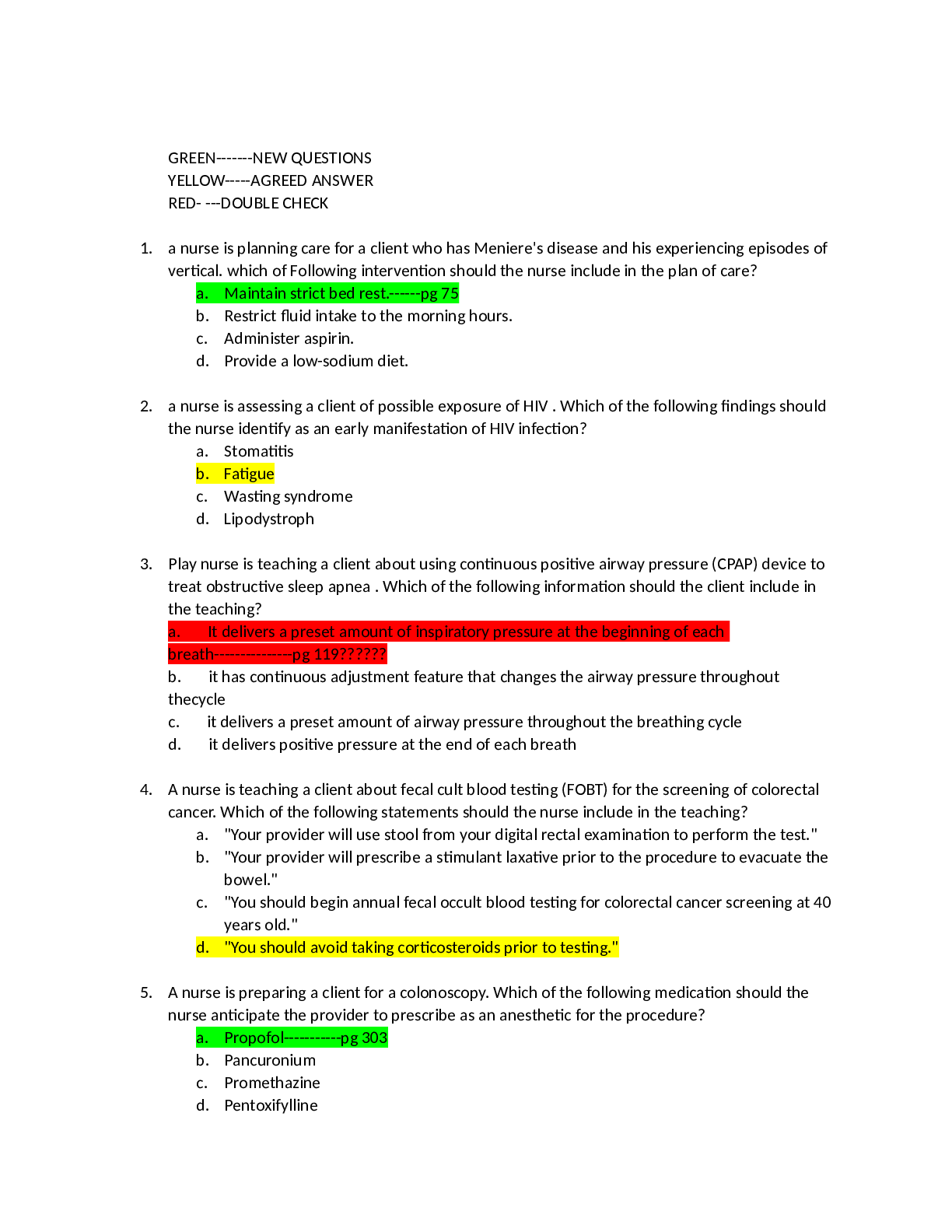


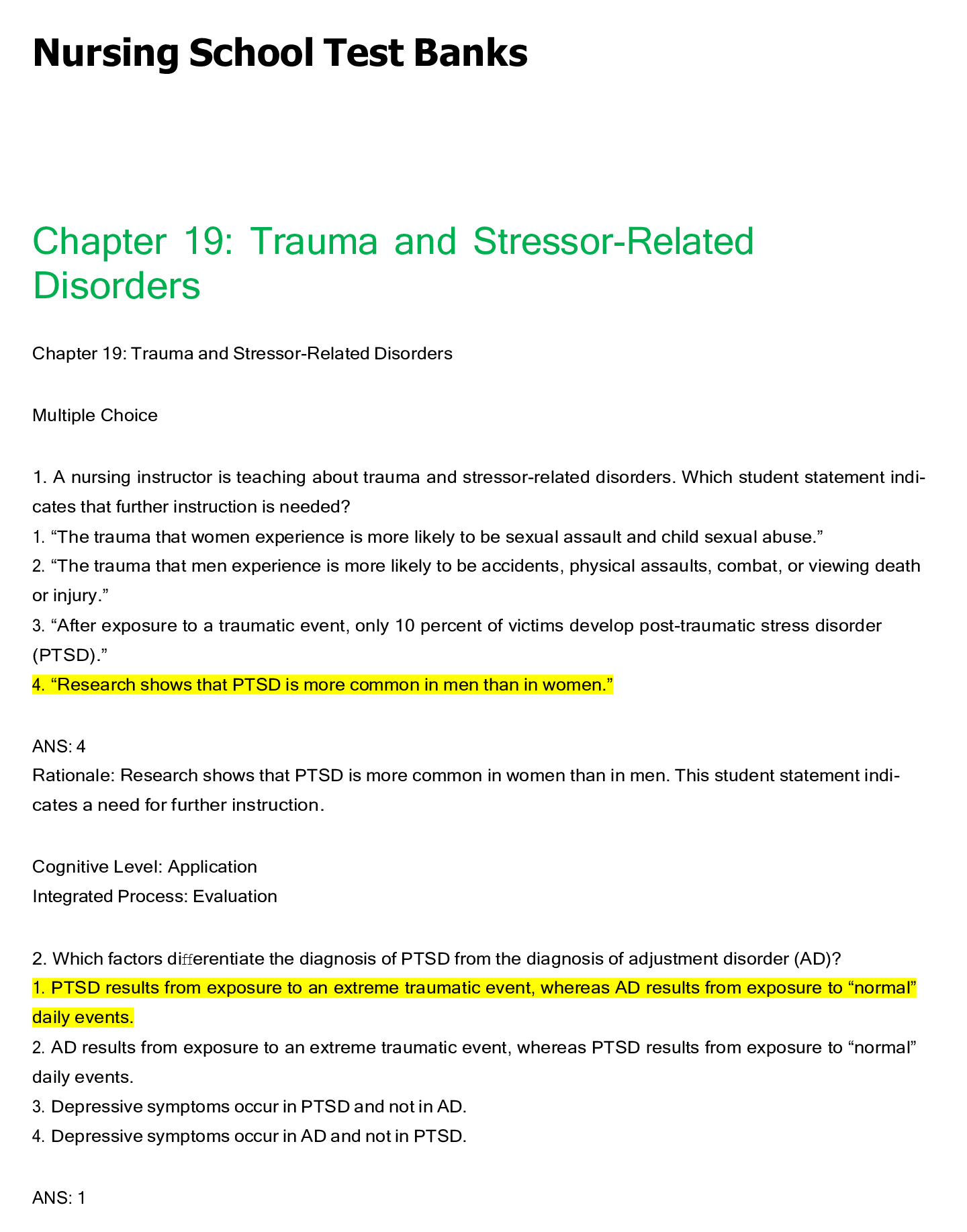
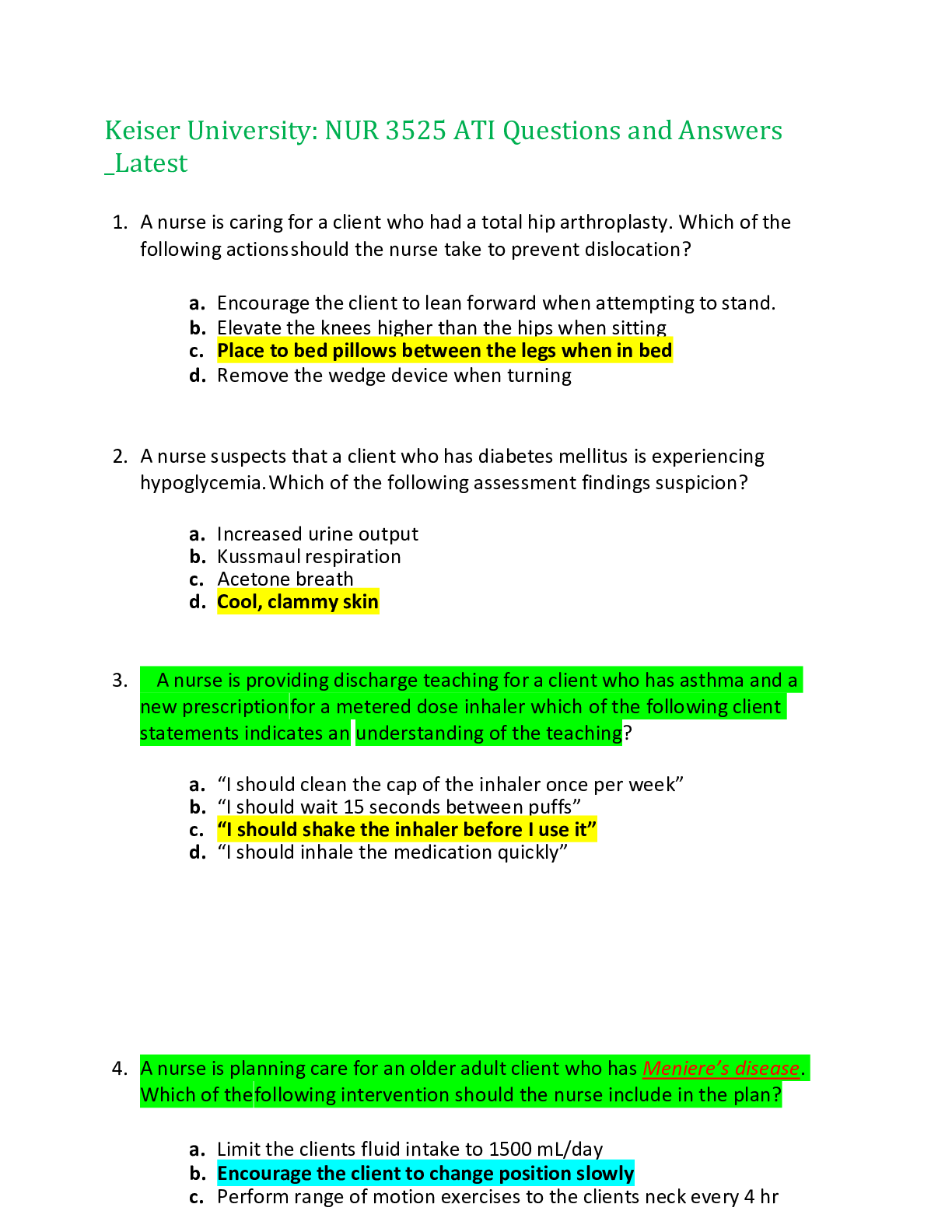

 (1).png)
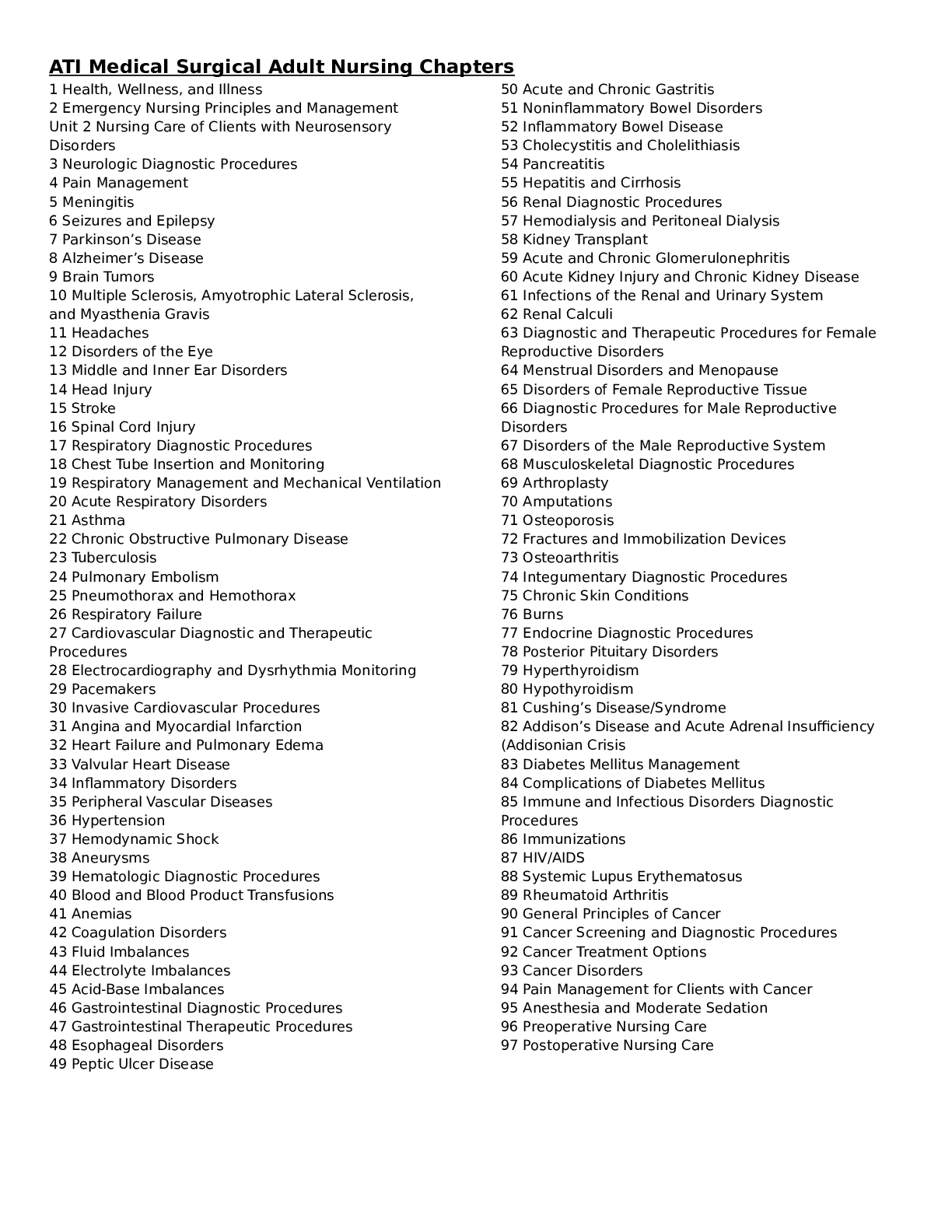

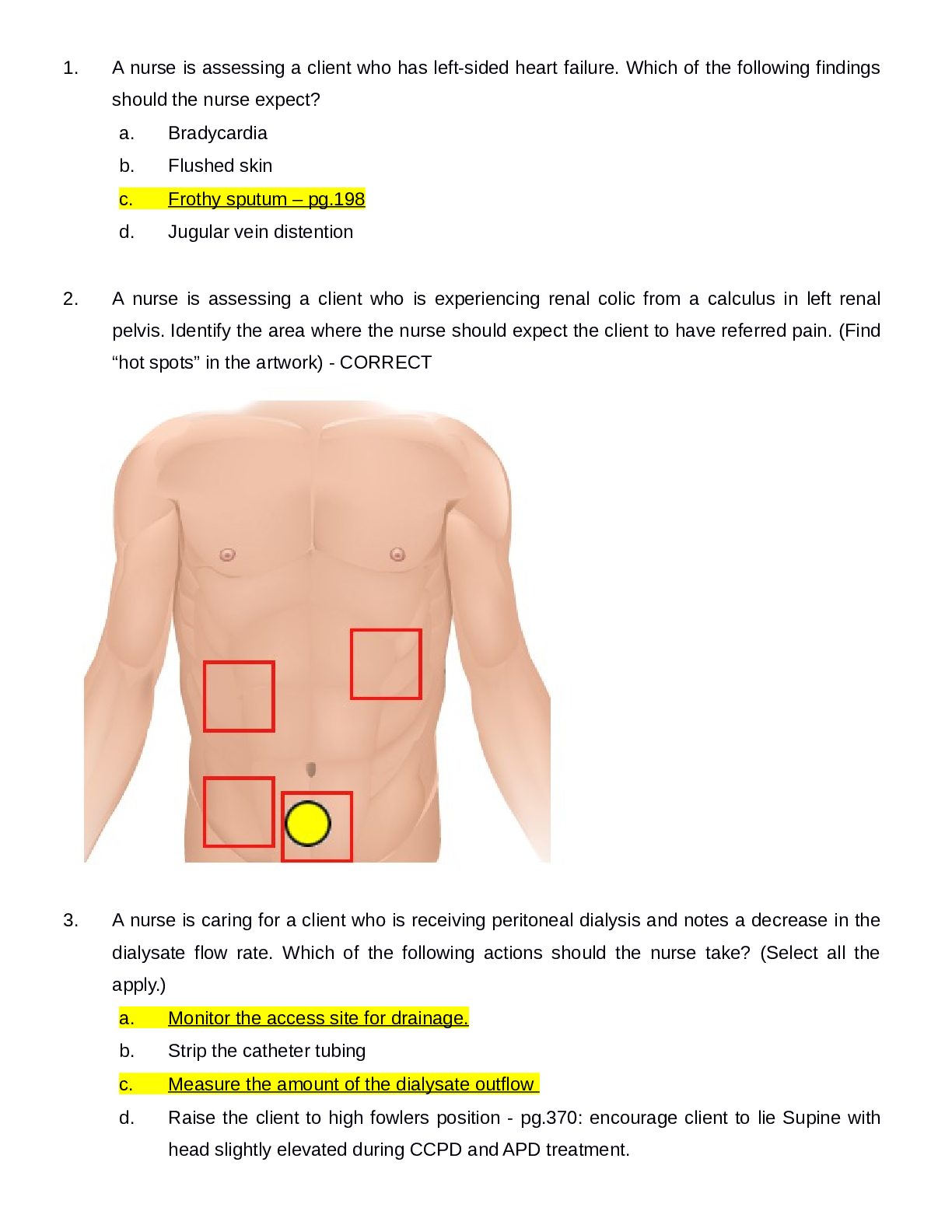
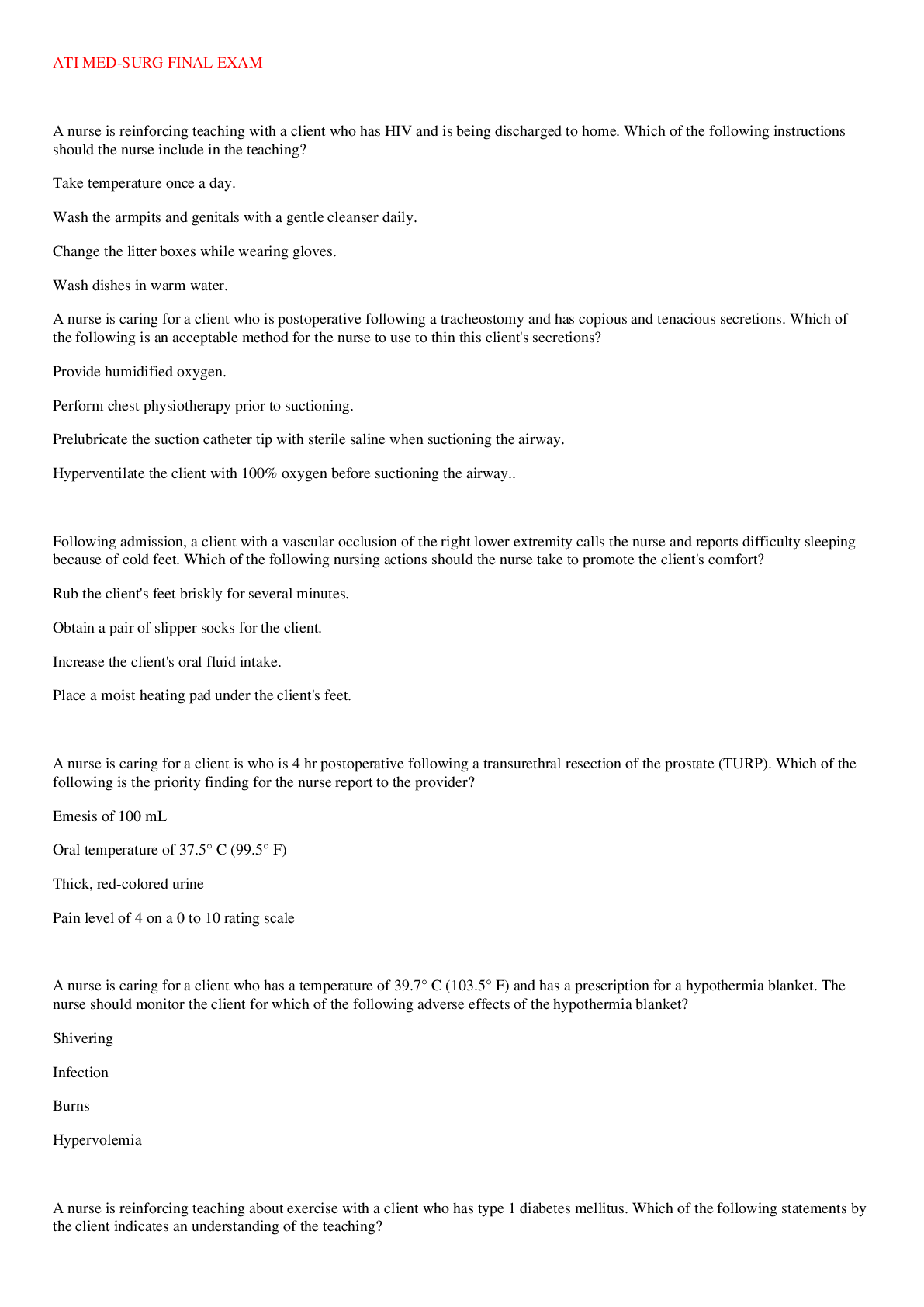

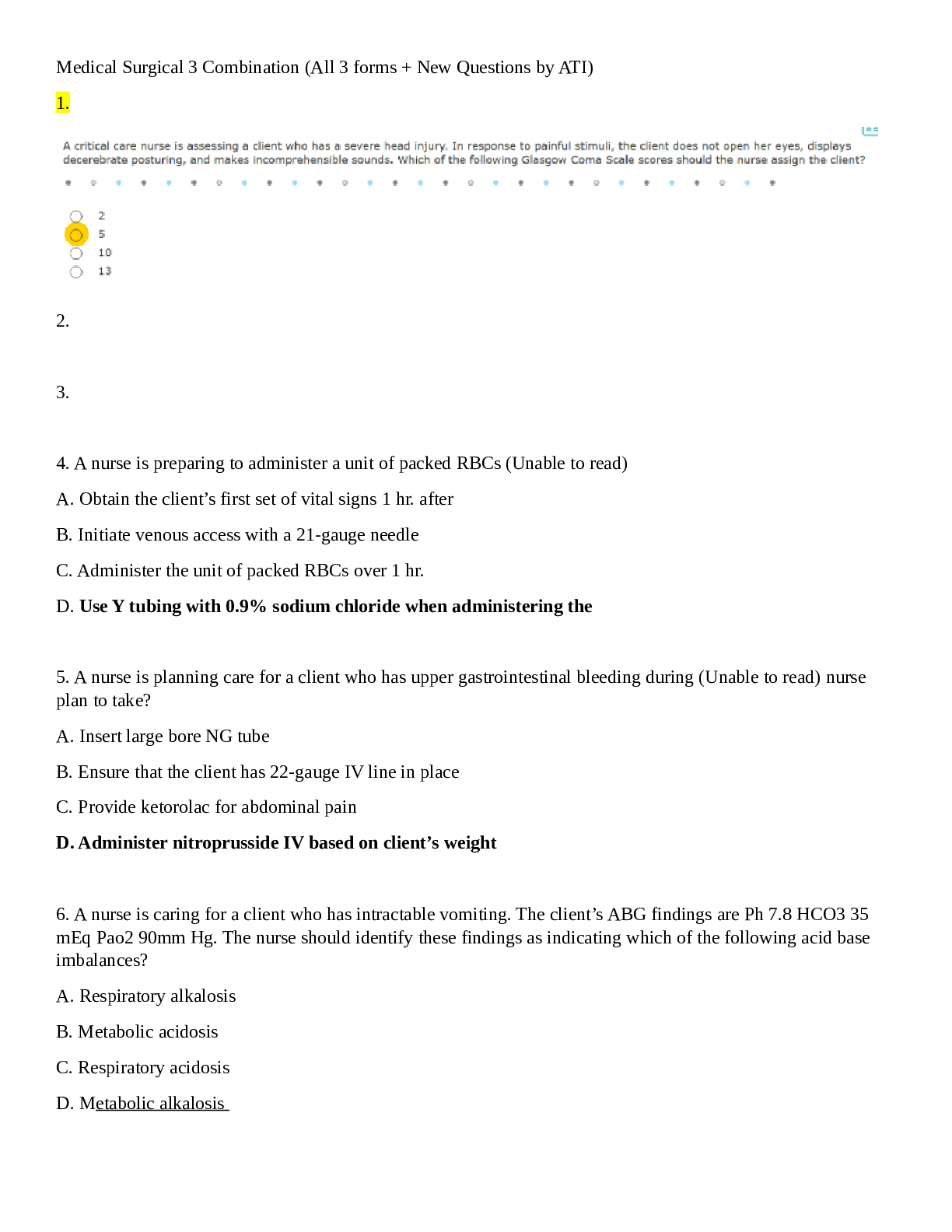
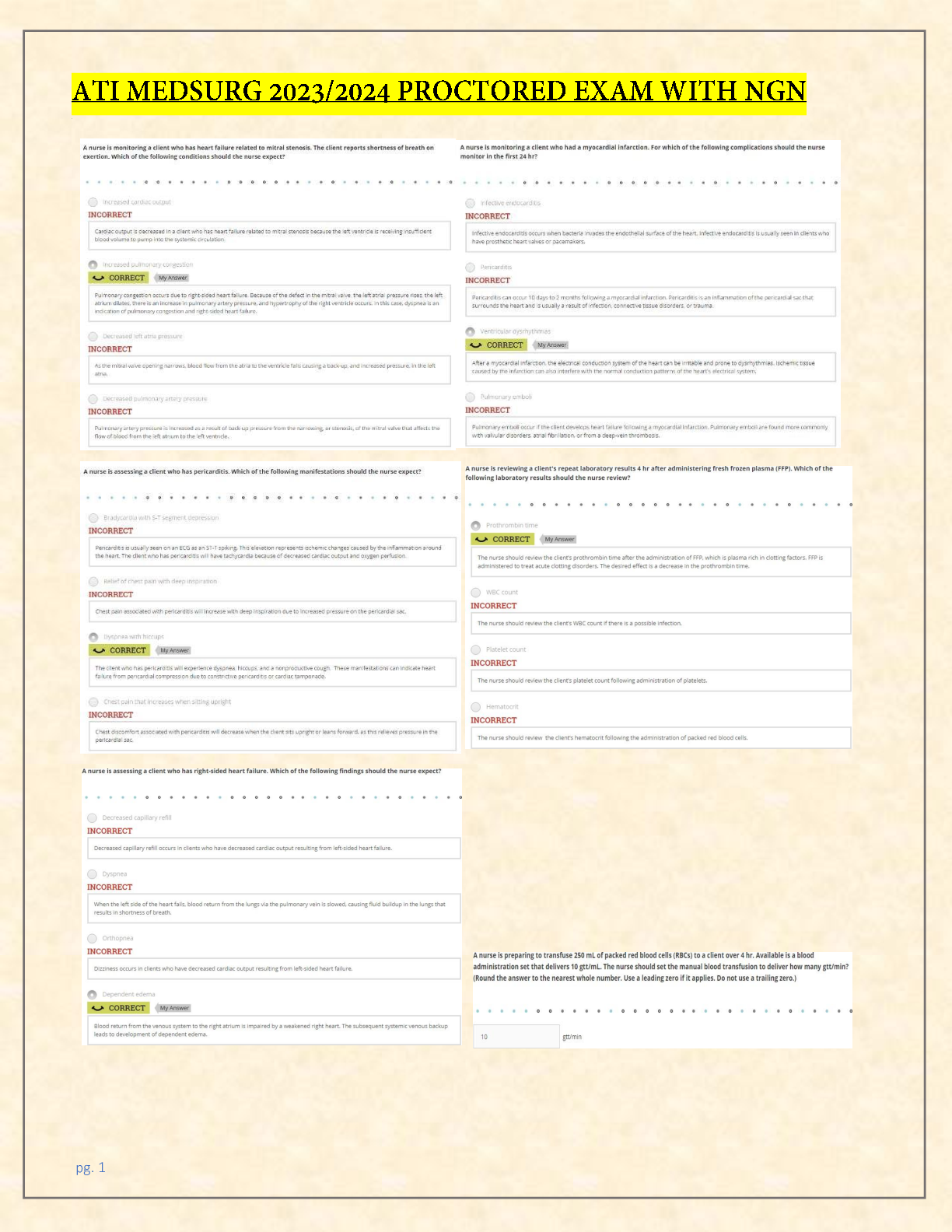
 – Chamberlain College of Nursing.png)


